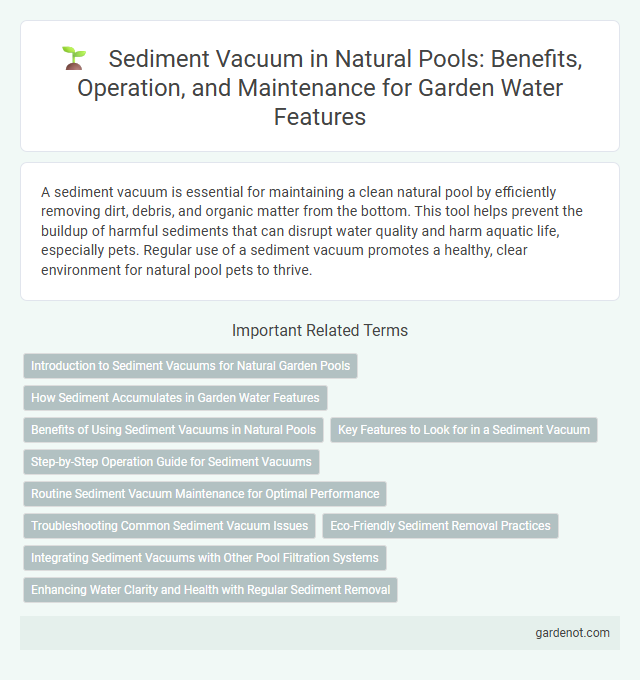A sediment vacuum is essential for maintaining a clean natural pool by efficiently removing dirt, debris, and organic matter from the bottom. This tool helps prevent the buildup of harmful sediments that can disrupt water quality and harm aquatic life, especially pets. Regular use of a sediment vacuum promotes a healthy, clear environment for natural pool pets to thrive.
Introduction to Sediment Vacuums for Natural Garden Pools
Sediment vacuums are essential tools for maintaining the clarity and health of natural garden pools by efficiently removing organic debris, silt, and sediment buildup. These devices work by sucking up particles that accumulate at the bottom, preventing nutrient overload and algae growth that can disrupt the pool's ecosystem. Regular use of sediment vacuums supports balanced water quality and promotes a thriving habitat for aquatic plants and wildlife.
How Sediment Accumulates in Garden Water Features
Sediment accumulates in garden water features primarily through organic debris, soil particles, and algae settling at the bottom, which can cloud the water and disrupt the ecosystem. Sediment vacuum systems efficiently remove these deposits by suctioning out fine particles and detritus, maintaining water clarity and promoting healthier aquatic environments. Regular sediment removal prevents clogging of filters and supports the growth of beneficial plants and microorganisms in natural pools.
Benefits of Using Sediment Vacuums in Natural Pools
Sediment vacuums efficiently remove organic debris, leaves, and fine particles from the bottom of natural pools, preventing the buildup of sludge that can lead to algae growth and water quality deterioration. Using sediment vacuums reduces the need for chemical treatments by maintaining a balanced aquatic environment, promoting healthier ecosystems within the pool. This process also extends the lifespan of filtration systems by minimizing clogging and reducing maintenance frequency.
Key Features to Look for in a Sediment Vacuum
Key features to look for in a sediment vacuum for natural pools include powerful suction capacity to efficiently remove fine particles and debris, a durable and corrosion-resistant construction compatible with natural pool materials, and adjustable hose length for flexible reach in various pool depths. An integrated filtration system that prevents clogging and easy-to-clean components enhance maintenance convenience. Look for energy-efficient models with ergonomic design to ensure user comfort during prolonged cleaning sessions.
Step-by-Step Operation Guide for Sediment Vacuums
To operate a sediment vacuum effectively in a natural pool, first assemble the vacuum by attaching the telescopic pole and vacuum head, then connect the hose to the skimmer or pump outlet. Submerge the vacuum head into the pool, ensuring that the hose remains filled with water to maintain suction, and slowly move it over sediment-rich areas. Finally, regularly check and empty the collection container or filter bag to prevent clogging and maintain optimal cleaning performance.
Routine Sediment Vacuum Maintenance for Optimal Performance
Routine sediment vacuum maintenance ensures optimal performance by preventing sediment buildup that can compromise water clarity and filtration efficiency in natural pools. Regularly cleaning filters, inspecting hose connections, and emptying collection bags maintain suction power and extend the vacuum's lifespan. Consistent upkeep reduces the risk of equipment damage and keeps the aquatic ecosystem balanced and healthy.
Troubleshooting Common Sediment Vacuum Issues
Sediment vacuum issues often stem from clogged filters or improper hose connections, reducing suction efficiency and hindering debris removal in natural pools. Inspecting and cleaning the vacuum's filter regularly prevents blockages that impair sediment extraction, ensuring optimal water clarity and ecosystem balance. Checking for air leaks in hoses and securely attaching all connections restores proper suction power, facilitating effective sediment removal and maintaining the natural pool's health.
Eco-Friendly Sediment Removal Practices
Eco-friendly sediment removal practices in natural pools utilize sediment vacuums designed to minimize disruption to aquatic ecosystems while effectively extracting organic debris and silt. These sediment vacuums operate with low-energy consumption and avoid harmful chemical use, preserving water quality and promoting biodiversity. Implementing biodegradable filtration systems further enhances sediment management by reducing environmental impact in natural swimming environments.
Integrating Sediment Vacuums with Other Pool Filtration Systems
Integrating sediment vacuums with natural pool filtration systems enhances water clarity by efficiently removing debris and organic matter before it reaches biological filters. Combining sediment vacuums with plant-based filtration and mechanical skimmers creates a comprehensive multi-stage cleaning process, reducing maintenance requirements and promoting healthy aquatic ecosystems. This integration supports sustainable water management by preventing sediment accumulation that can disrupt the balance of microbial activity essential for natural pool health.
Enhancing Water Clarity and Health with Regular Sediment Removal
Regular sediment removal using a sediment vacuum significantly enhances water clarity and promotes a healthier natural pool environment by preventing the accumulation of organic debris and algae growth. Efficient sediment extraction reduces nutrient build-up, minimizing the risk of water contamination and supporting balanced aquatic ecosystems. Consistent vacuuming also improves filtration system performance, ensuring crystal-clear water and a safe swimming experience.
Sediment vacuum Infographic

 gardenot.com
gardenot.com